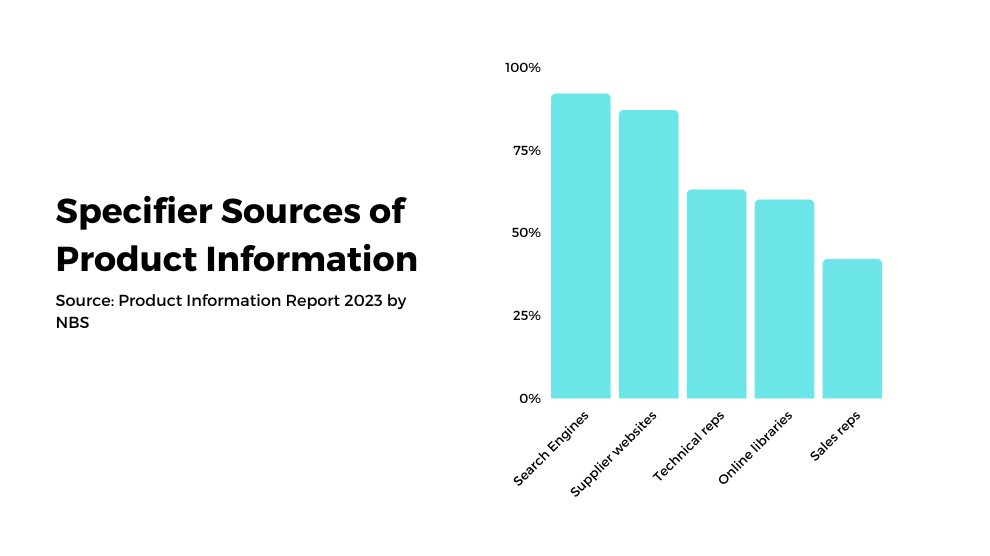4 min read
Specification Marketing: Why Digital Specialists Get it Wrong
![]() Jack Meisinger
:
16-Mar-2023 16:28:42
Jack Meisinger
:
16-Mar-2023 16:28:42

Building product businesses are racing to support specifiers’ online specification research process, but are not getting the best advice on how to do this. Digital specialists are not generally construction specialists, and often don’t understand the complexities of the industry and the specification route to market.
Before we go any further on this, first let’s address what makes the digital specification research process so important.
Recent changes in specifier behaviour have highlighted the need for building product businesses to support a primarily self-educational specification research process. NBS reports that 92% of specifiers turn to online search for product information first. In second place are manufacturers’ websites with 87%. Only after this come technical sales reps with 67%.
Previously, technical sales reps would have been the sharp end of the spear. Now, they are speaking to specifiers who are 80% of the way to making a decision. After the specifier has googled “x” type of product for “y” type of project. Then browsed a few websites, checked out technical documentation and case studies, looked for any additional resources, and then finally give the technical team a call. If a building product business fails to show up in search and then support the research process properly, it won’t be getting that call at all.

Businesses are starting to realise that specification marketing necessitates retooling and upgrading the way they engage specifiers and are turning to digital specialists for help. However, digital specialists are not necessarily construction specialists. They produce pixel-perfect header images and responsive websites but are not aware of what specifiers want from websites. They don’t understand the specifier’s journey or the user experience design that best facilitates it. They don’t understand what types of additional resources would make the website not only look great, but help increase enquiries, speed up sales cycles, and grow revenue.
Let’s look at specifiers’ digital research journey and identify the best type of resources to improve it.
Mapping Specifiers’ Digital Research Journey
Specifiers go through a process of researching the best products for a particular project and ensuring that they are suitable for its environment. They need to consider cost, availability and quality when specifying a product. Finally once a short list of products have been drawn up, specifiers will review documentation associated with the product such as safety instructions, warranties and installation instructions before recommending it for use.
You can support specifiers during their research journey by providing detailed product information such as technical specifications, performance data, product installation instructions and warranties. You can also provide sample products and demonstrate their use in a variety of environments. Additionally, you can make the research process easier by providing easily accessible product databases, catalogues and online customer support. Finally, the sales team should be available to answer questions and provide guidance throughout the research process.
Where Does the Research Process Go Wrong?
Many businesses fail to provide easily accessible product databases, catalogues and online customer support. For example, creating a clear product family structure, with clear hierarchy, and product names (not numbers) helps specifiers navigate product pages. Additionally, many businesses lack the technology to support queries and the staff availability to answer questions or provide guidance throughout the research process. Poor communication from building product businesses can make the research process more difficult and time-consuming for specifiers.
Poor communication and support from building product businesses can negatively impact the specifiers' likelihood to specify their product. Without access to relevant and timely product information, it is difficult for specifiers to assess the feasibility of a certain product for their project. Additionally, if guidance is unavailable during the research process, specifiers may not feel confident in their final decision and may seek other alternatives.
What Materials Best Support The Specifiers Research Process?
The following are factors that influence specifiers' selection of products for their projects:
- Product availability
- Cost
- Safety
- Quality of product
- Durability and life cycle costs
- Flexibility in customization and design
- Building product businesses' customer support and communication
- Ability to meet project specifications and regulations
- Maintenance requirements and ease of use
- Sustainability certifications
- Reputation and industry awards
You can start to compile all the necessary product information and make it accessible to specifiers in a number of ways:
- Create comprehensive fact sheets detailing product specifications, usage recommendations, and technical data.
- Publish user guides with step-by-step instructions
- Provide easy access to product certification and testing documents.
- Develop a library of supporting visuals such as diagrams, photographs, and videos that illustrate usage options.
- Create an eLearning module or online training resource that allows specifiers to get up to speed quickly with the latest product updates
Providing comprehensive product information to specifiers enables them to assess the suitability of the product for their project and make an informed purchase decision. Documentation, such as user guides and eLearning modules, reduce the time spent on research and provide a ready source of in-depth product knowledge that can answer questions when the technical team is unavailable. Visible certification documents could serve as a quick reference point during design review meetings. Access to images, diagrams, and videos give specifiers valuable visual references for presenting their projects to clients or constructing models.
Having comprehensive product information readily available to specifiers increases the likelihood that your product will be specified because it demonstrates that the you are committed to providing good customer service and responding promptly to questions. Also, documented specifications, certifications, and user guides are essential for specifiers during design review meetings. Product images, visuals, and videos help specifiers effectively communicate their ideas to clients. Easy access to technical data and usage recommendations gives specifiers assurance that the product meets their requirements and supports their objectives.
Improving the Specifiers Research Journey
The main obstacle for building product businesses to provide comprehensive product information to specifiers is time and resources. Creating user guides, eLearning modules, certification documents, images, diagrams, and videos can be a time-consuming process. Additionally, they may require the input of experts in various fields or access to specialized tools that can increase the cost of implementation.
You can overcome these time and resource constraints by outsourcing their product information development needs to specialized professionals. Professionals that have experience in creating technical documents, eLearning modules, images, diagrams, and videos can help building product businesses produce comprehensive product information quickly and cost-effectively. Additionally, by leveraging existing resources such as digital asset libraries or CAD/CAM systems, building product businesses will be able to reduce the amount of time needed for content creation.
However, the challenge remains. This is a big project. How do you create a project road map? What are the priorities? What content do you already have and where are the gaps?
Insynth is hosting an exclusive Specifier's Digital Research Journey Workshop this spring. It will cover how to create a road map that prioritises the most crucial projects first, and what most businesses miss off the list. If you are interested in attending, please register your interest here.
Conclusion: Staying Competitive by Supporting Self-Education
In conclusion, it is clear that building product businesses must understand the digital specification research process if they want to remain competitive in today's market. Specifiers won’t talk to your technical team if they didn’t find you online, or find what they were looking for on your website.
To make sure you are providing the material for them to sufficiently self-educate to the point where they are comfortable making an inquiry, you must provide comprehensive product information, databases, catalogs and online customer support that is easily accessible, and be available to answer questions throughout the research process. With these steps in place, you will be better able to meet specifiers' needs and ultimately grow your business.


